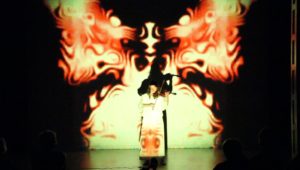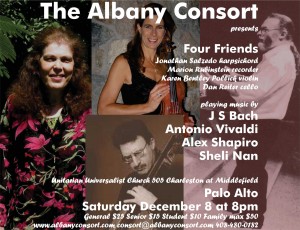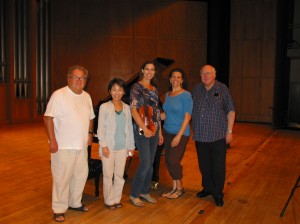Genesis of MAQA VIOLIN
MAQA VIOLIN by Yitzhak Yedid
Live performance recorded at Casa Luz de Luna in San Pancho, Nayarit on December 6, 2021
Karen Bentley Pollick, violin
Cameras: Benjamin Ramauge & Levi Zortman
Edition: Benjamin Ramauge
MAQA VIOLIN, in 5 parts and c. 17 minutes’ duration solo piece, was conceived in 2018 by Israeli-Australian composer/pianist Yitzhak Yedid in Brisbane, Australia during his prolific two-year period of composition funded by the Sidney Myer Creative Fellowship. Composed for a triumvirate of virtuoso violinists: Graeme Jennings, Karen Bentley Pollick and Hagai Shaham, MAQA VIOLIN was workshopped and premiered by Jennings at Darmstadt Summer School and Festival in July 2018. Karen gave the US premiere in Seattle, Washington on September 6, 2018 at the Chapel Performance Space at Good Shepherd Center. The creation of MAQA VIOLIN has been assisted by the Australian Government through the Australia Council, its arts funding and advisory body.
The work is a synthesis of musical traditions, colours, textures and energies. It explores maqamat (Arabic modal system) and avant-garde with traditional melodic and formal conventions. In Part 1 (a’ la maqam Saba) the tetrachord of Saba (D, E 1/4 flat, F, G flat) permeates a lively Arabic folk dance alternating between rhythmic riffs and chromatic melodies. In Part 2, a’ la maqam Hijaz, Hijaz mode (C, D flat, E, F, G, A, B flat) is being exploit in a wide range of pizzicato techniques in a 10/8 + 7/8 meter and Presto tempo. Rapid firing 1/16th notes, tremolos a la mandolin, right and left hands slapping the fingerboard, and strumming in guitar position constitute a tour de force musical image. A’ la Taqsim (Part 3) is an improvisatory movement emerging from the low A to establish the tonal center before embarking into sul tasto extreme alternating with sul ponticello extreme, playing in the highest register with the fingernail of the left hand, all framing the plaintive ascending melodies high on the G string. Part 4, a’ la maqam Sikah Baladi (G, A flat, B, C, D, E flat, G sharp) is a chromatic virtuoso Vivacissimo, staccattissimo dance for the bow with glissandi up, down and around the maqam tones. An Ecstatic Debqa Dance (Part 5) is the finale, replete with non pitched percussive effects, Arabic folk dance accompanied by foot stomping, aleatoric pizzicato, sul ponticello, and bow slapping and sliding.
The genesis of MAQA VIOLIN began in 2012 while Yitzhak was rehearsing with the Seattle Chamber Players towards the premiere of his Sextet in Homage to Jerusalem. My mother Nan Bentley hosted him for a week in her spacious Queen Anne home and regaled me on the phone about his piano playing and jazz improvisations on her vintage Hamburg Steinway. Her contribution to their ongoing conversations over her home cooked meals was a suggestion that he compose a solo violin piece for her daughter. The seeds for MAQA VIOLIN were planted thus. Shortly thereafter I met Yitzhak at the Queensland Conservatorium in Brisbane while on tour with Paul Dresher Double Duo in May 2013. We enjoyed a con brio conversational at a cafe al fresco under bougainvillea trellises by the shore and expressed our mutual interest for a collaboration.
In 2018 MAQA VIOLIN arrived in the early summer. I immediately dove into the intricate score and added Arabic instrumental and vocal music, especially Fairouz’s passionate renditions, to my listening queue. We had numerous coachings via Skype video in the early mornings from my home studio in San Pancho, Nayarit on the Mexican West Coast to mind the time gap with Australia. These sessions focused and polished my interpretation and approach to a new genre with nurturing guidance and courage from the composer to convey his intentions and ensure thorough preparation for the US premiere in Seattle on September 6, 2018. The circle from conception to concert was completed with my mother and her friends in the audience to experience Yitzhak’s new piece on a multi media concert Violin, Viola & Video Virtuosity.
In early 2021 Yitzhak composed a short solo violin piece Compassion Niggun that I filmed in my San Pancho studio in February and performed a few times at house concerts. We rekindled our energies towards reviving MAQA VIOLIN and made plans to film in late December, resuming our sessions in November over Facebook Videochat between his home in Jerusalem, where he was preparing for the Israeli premiere of his Kiddushim Ve’ Killulim (Blessings and Curses), and my home in San Pancho, after returning from a two month tour of the US. I encountered significant logistical hurdles for the second half of 2021 with a 5 month floor replacement project that rendered my studio unavailable. Nevertheless I practiced MAQA VIOLIN passionately for two weeks amidst sonic and physical chaos in my environs with the goal of completing the video in 2021. I enlisted my neighbor Benjamin Ramauge to capture the video. After several site visits we agreed that my great room devoid of any furniture or carpets was the optimum venue in our pueblo. The new cantera stone was completed and we set up the camera angles, lighting and placement of violinist in the scene, blessed with a quiet Monday night for the shoot.
Benjamin completed the editing of MAQA VIOLIN from his new bakery, where he bakes sourdough bread in the mornings and is available for post production meetings while waiting for his customers. His keen artistic eye, agility with the camera from the low shots on the floor to capture the foot stomping sections, and expert montage bring a new perspective to MAQA VIOLIN beyond the concert hall. The intimacy of our project invites the viewers into my inner sanctum of intensity and zooms in and out of shots to highlight the extended techniques that challenge the violinist.
For the second pizzicato movement I used my outdoor violin with a guitar pick for optimum clarity and sonority to liberate from concern about damaging the varnish on my Vuillaume that is played in the other four movements. One week prior to filming I decided to move the violin into guitar playing position, anchoring it for stability between my left forearm (with bruises as evidence) and hip. I procured a pair of Warm Audio 84 condenser mics that I used for the first time in this recording along with the built in omni mic on my ZOOM H6 recorder for a blend of room and close miking.
I look forward to bringing MAQA VIOLIN back into the concert hall and am grateful for the abundant time and resources that we enlisted towards the creation of this video. I dedicate this performance to the memory of my beloved mother Nan Bentley, who continues to bring favorite characters in her orb together through artistic pursuits and eternal appreciation.
Musings from the Pietà Muse
|
|
|
|
|
|
Baroque Fantasy live performance from Seattle now on YouTube
Stuart Diamond, Baroque Fantasy for Violin & Video
Karen Bentley Pollick, Violin
The Chapel at Good Shepherd Center
Seattle, Washington
November 16, 2012
Technical Director: Vance Galloway
Camera: Cameron Jessup
Original Video footage recorded at Metropolitan State College Studio in Denver on July 12, 2012: Sam McGuire, engineer
PROGRAM NOTES
“Baroque Fantasy” was originally commissioned by Max Pollikoff, founder of “Music in Our Time,” the landmark modern music series performing primarily at the 92nd Street Y from the 1950’s through to the late 1970’s. One of the leading contemporary music violinists of his day, he asked me to write a solo violin work. Delving into the great solo works of Bach, Ysaÿe and others, I sought to write a work that hearkens back to the music of those earlier eras, yet through the refraction of a modern prism. Max premiered Baroque Fantasy in 1974 and it immediately became one of his favorites, a signature piece that he performed repeatedly for the rest of his career.
Karen Bentley Pollick ‘s performance at our “Electric Diamond” concert at The Walker Stage in Manhattan in June 2012 was the first performance since Max’s last recital. In July she suggested that I create a video accompaniment to the work for her upcoming “Violin, Viola & Video Virtuosity” production in New York and Seattle. I took the original video footage from the recording of the work and combined it with other visual elements — primarily Rocco images of European church architecture and a few computer generated effects. Treating the limited visual elements as though they were musical motifs I created a parallel visual world as an accompaniment to the music. I then took the video of the Karen’s performance in Seattle and recombined all the elements again to create the present version of “Baroque Fantasy.”
–Stuart Diamond
For more information please visit: www.stuartdiamond.com and www.kbentley.com
Jeffrey Harrington Grand Tango for Violin & Video on YouTube
Our Violin, Viola & Video Virtuosity performance in Seattle coincided with the Leonid meteor showers on an overcast evening to fuel a cascade of indoor fireworks during the performance of Jeffrey Harrington’s Grand Tango for Violin & Video that is now on YouTube.
Jeffrey Harrington, Grand Tango for Violin & Video
Karen Bentley Pollick, Violin
The Chapel at Good Shepherd Center
Seattle, Washington
November 16, 2012
Technical Director: Vance Galloway
Video: Cameron Jessup
Violin: Karen Bentley Pollick
http://www.kbentley.com
“When I moved to Avignon, France in 2010 I had already begun a series of tangos and I had no idea I was moving into the heart of the French tango territory itself, Nimes, which is 25 miles away. Needless to say, we’re surrounded by tango music and many of our local friends are tango dancers themselves.
My music has always sought to exploit under-explored melodic and rhythmic territories from around the world without openly quoting or utilizing pastiche. Grand Tango for Solo Violin is written in the tradition of the concert tango and was inspired not only by the popular traditional music but also by the virtuoso solo violin music of Bach.The video for Grand Tango for Solo Violin was created by computer processing public domain tango video footage frame by frame and then editing it to loosely match a recording Karen had provided me. I used a combination of effects, including creating different types of chaotic dispersion fields around each image that produces a halo of curves and waves that I then colored in various ways. At various moments of the video I used mirroring effects, which give each image a mandala-esque appearance. The end result is a video creating a continuous stream of various forms of abstraction for each the dancer’s movements. Original source material of the video shot by Jeff Mission, Travis Vautour, and Leonid Andreev at the Redtail Collective, Boston, MA. Lighting by Travis Vautour. Editing and post-production by Jeff Mission. Dancers: Eve and Keki.”
Jeffrey Harrington
Karen Bentley Pollick is one of America’s leading contemporary violinists and violists. She has premiered hundreds of new compositions across a diverse range of styles. Presently she tours with Two Sense pianist Lisa Moore and the Paul Dresher Double Duo, as well as with Russian pianist/composer Ivan Sokolov. She received a grant from the National Endowment for the Arts for her 2010 Solo Violin and Alternating Currents concerts. “Rarely will a recital such as this engage the ear from beginning to end, yet each piece at Birmingham Museum of Art event had a unique style and temperament, reflecting Pollick’s keen sense for gleaning quality in experimental music and giving these scores their rightful due… Pollick not only extended that thread, she vitalized and emboldened it.” Michael Huebner, Birmingham
Jeffrey Harrington was born and raised in the Deep South, spending most of his formative high school years in New Orleans, Louisiana, where he became personally familiar with many great blues artists with his work at the New Orleans Jazz Festival. While he has studied with many famous composers at Juilliard and Tulane, including Elliott Carter and Roger Sessions, he attributes his musical education to self-study.
Jeffrey Harrington’s music is characterized by New Orleans-influenced rhythms, and intense counterpoint and climaxes. A noted microtonalist and electronic experimentalist, he was also one of the first musicians to adopt the Internet for music distribution and promoting, starting in 1987 with RelayNet emails and BBS downloading. He is likely the first composer to utilize the Internet to further his career, and probably invented the free music distribution model. By employing pre-web computer systems he distributed his music (both scores and all recordings) to musicians and listeners around the world free of charge garnering worldwide performances and attention. He continues to do so to this day at his site: http://jeffharrington.org. Harrington moved to Avignon, France in 2010 after his home on Sanibel Island was threatened by the oil spill. In November 2011, Harrington had 4 world premieres across the globe in 20 days, two in Germany by Duo Ahlert und Schwab and The Twiolins, one in London, by Camilla Hoitenga, and one in Southern California by The Hutchins Consort.
The score to Grand Tango is available for free download:http://imslp.org/wiki/Grand_Tango_for_Solo_Violin_(Harrington,_Jeffrey_Michae…
More music: http://jeffharrington.org
http://open.spotify.com/artist/1SlRSnxbcQTZfiUOgGH2zA
http://jeffreyharrington.org/mp3/harrington.html
Albany Consort performs at Stanford and Palo Alto on December 7 & 8, 2012
The Albany Consort presents
Four friends in an eclectic mix of styles and a guarantee of no Christmas themes!
A sonata for organ by Johann Sebastian Bach, in Marion Rubinstein’s arrangement for recorder, violin, cello and harpsichord. A violin concerto by Antonio Vivaldi, in his own arrangement for the same group. A sonata for violin and harpsichord by Bach, untarnished other than by the inspiration of the moment. And two new pieces for violin and harpsichord by Alex Shapiro and Sheli Nan.
In his sonatas for violin and harpsichord, Bach paved the way for the two instruments to have an equal say when playing together. Sheli Nan’s Absinthe is identifiably in this tradition, a lovely mellow musical account of a meeting of two close friends on a rainy day. Alex Shapiro’s Slip is anything but in any tradition – bringing together the greatest number of different styles ever to be found in a single piece of music – Cuban, Egyptian, Indian, Japanese, Irish, Italian, Bluegrass, Rock-n-roll, Hot Club quintet, Greek – but ironically with no reference to the eighteenth century at all.
The virtuoso ensemble of friends for this program consists of Marion Rubinstein (recorder), Karen Bentley Pollick (violin), Dan Reiter (cello) and Jonathan Salzedo (harpsichord).
Friday, December 7, 2012 at 12:30 pm
Stanford Hospital Atrium, Bing Concert Series
Free Admission!
and
Saturday, December 8, 2012 at 8:00 pm
Unitarian Universalist Church of Palo Alto
505 East Charleston Road
Palo Alto, California 94306
General Admission: $25 Senior $15 Student $10 Family maximum $50
albanyconsort.com consort@albanyconsort.com (408) 480-0182
Estadio for Viola by Greg Simon now at CDBaby
Release date: October 24, 2012
Violist Karen Bentley Pollick performs Estadio: a lush, introspective elegy by young composer Greg Simon.

Now available as a download from CDBaby!
On September 15, 1973, Chilean songwriter and activist Victor Jara was murdered by the military forces who, days earlier, had overthrown Salvador Allende’s Popular Unity government. His last days were spent in captivity; along with thousands of innocent Chileans, he was detained by the military junta in Estadio Chile, the national stadium. The details of his death aren’t clear, but what is known is that even in his last days he was sketching for a new song, which he had named after the stadium which would hold him until his death.
Estadio was written in memory of Victor Jara, one of my most important and personal musical heroes. Its main themes are drawn from two of my most beloved of his songs, “El Derecho de Vivir en Paz” and “El Alma Llena de Banderas.” Like his last work, it is named after the stadium in which he spent his final days.
Estadio was written for Andrew Krimm, during a residency at the Brevard Music Center.
Recorded at Metropolitan State College Studio in Denver, Colorado on May 24, 2012
Sam McGuire, Engineer
Cover photo: Karen Bentley Pollick
Graphics: Greg Simon
Viola by William Whedbee, 1987
VVVV Press Release November 11 in Brooklyn; November 16 in Seattle
Karen Bentley Pollick performs “Violin, Viola & Video Virtuosity” on Sunday, November 11, 2012 at 3:00 pm at the Firehouse Space: 246 Frost Street in Brooklyn, New York 11211.
Tickets $10 at the door. Take the L Train to Graham Avenue.
For more information contact:
Sandra Sprecher (917) 709-7799
Karen Bentley Pollick performs “Violin, Viola & Video Virtuosity” on Friday, November 16, 2012 at 8:00 pm at the Chapel of Good Shepherd Center: 4649 Sunnyside Avenue North, Seattle, Washington 98103
Tickets $5-15 sliding scale at the door.
For more information contact:
Steve Peters (206) 789-1939
http://waywardmusic.blogspot.com
With Violin, Viola & Video Virtuosity Karen Bentley Pollick breaks old stereotypes of solo string concert formats. Each work on the program was created expressly for Ms. Bentley Pollick and explores the synergy of video and solo strings to comprise a concert presentation in which the visual is as important as the auditory, where sound and image combine to explore new horizons of artistic possibilities.
The program features world premieres of Jeffrey Harrington’s Grand Tango for violin with tango infused video created by the composer; Seattle composer Nat Evans’ and video artist Erin Elyse Burns’ desert scape Heat Whispers; and New York composer Stuart Diamond’s prismatic video that he created for his 1974 Baroque Fantasy for violin, a work championed by the late Max Polikoff.
New York video artist Sheri Wills‘ videos are featured in Sapphire for violin and electronics (2010) by New York composer Preston Stahly; Dilemma for viola (1987) by Czech composer Jan Jirásek; The Red Curtain Dance for viola (2003) and Letter to Avigdor for violin (1990) by Israeli American composer Ofer Ben-Amots; and Metaman for violin with digital sound & video (2009) by Rome Prize winner Charles Norman Mason. Sheri’s 5 videos represented on Violin, Viola & Video Virtuosity (filmed during the April 26, 2012 launch from Evergroove Studio in Evergreen, Colorado) can be viewed at: Sheri Wills Videos. Sheri’s video artistry is featured in the October/November 2012 issue of Art Voices Magazine.
Karen Bentley Pollick is one of America’s leading contemporary violinists and violists. She has premiered hundreds of new compositions across a diverse range of styles. Presently she tours with Two Sense pianist Lisa Moore and the Paul Dresher Double Duo, as well as with Russian pianist/composer Ivan Sokolov. She received a grant from the National Endowment for the Arts for her 2010 Solo Violin and Alternating Currents concerts. “Rarely will a recital such as this engage the ear from beginning to end, yet each piece at Birmingham Museum of Art event had a unique style and temperament, reflecting Pollick’s keen sense for gleaning quality in experimental music and giving these scores their rightful due…Pollick not only extended that thread, she vitalized and emboldened it.” Michael Huebner, Birmingham News
Program notes: Violin, Viola & Video Virtuosity
Baroque Fantasy video
I have been enjoying resurrecting Stuart Diamond’s 1974 composition Baroque Fantasy for Violin this summer, first at the Walker Stage in Tribeca on June 22 before heading into the recording studio at Metropolitan State College in Denver where I shot the source footage for this video with Sam McGuire engineering. Baroque Fantasy will have its next incarnation during upcoming Violin, Viola & Video Virtuosity concerts at the Firehouse Space in Brooklyn on November 11 and at the Chapel of Good Shepherd Center in Seattle on November 16 with live violin in tandem with the images on the screen.
Recording Ladislav Kubik’s music at FSU
We recorded Ladislav Kubik‘s setting of my poem Dawn for Mezzo Soprano, Violin and Piano on September 14, 2012 at FSU Recital Hall in Tallahassee, Florida with Vaclav Zamazal as our Engineer and Producer leading the session in Czech, German and English. Hearing Phyllis Pancella‘s velvet sonority and precise diction was a thrilling experience, elevating my words and images into another realm of comprehension and ecstasy. Hui-Ting Yang‘s solid and artistic pianism on the resident Fazioli grand piano provided the backdrop for Kubik’s romantic setting. Our rehearsals were joyous occasions and the meals and comraderie we enjoyed over the several days of intensive preparation were multilingual banquets exchanging sagas and insights on a wide range of topics. The fruit of our labors will be released in spring 2013 on the Qualiton/Neos label along with Kubik’s Duo Concertante and other songs.






